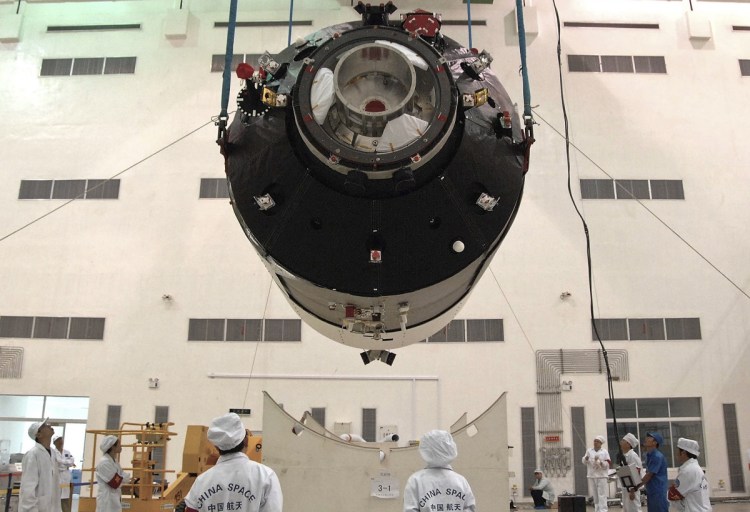BEIJING — China’s defunct and reportedly out-of-control Tiangong 1 space station is expected to re-enter Earth’s atmosphere sometime this weekend. It poses only a slight risk to people and property on the ground, since most of the bus-size, 8.5-ton vehicle is expected to burn up on re-entry, although space agencies don’t know exactly when or where that will happen.
Below are some questions and answers about the station, its re-entry and the past and future of China’s ambitious space program.
What will happen and how great is the danger?
The European Space Agency predicts the station will re-enter the atmosphere between Saturday morning and Sunday afternoon – an estimate it calls “highly variable,” likely because the ever-changing shape of the upper atmosphere affects the speed of objects falling into it.
The Chinese space agency’s latest estimate puts re-entry between Saturday and Wednesday.
Western space experts say they believe China has lost control of the station. China’s chief space laboratory designer Zhu Zongpeng has denied Tiangong was out of control, but hasn’t provided specifics on what, if anything, China is doing to guide the craft’s re-entry.
Based on Tiangong 1’s orbit, it will come to Earth somewhere between latitudes of 43 degrees north and 43 degrees south, or roughly somewhere over most of the United States, China, Africa, southern Europe, Australia and South America. Out of range are Russia, Canada and northern Europe.
Based on its size, only about 10 percent of the spacecraft will likely survive being burned up on re-entry, mainly its heavier components such as its engines. The chances of anyone on Earth being hit by debris is considered less than one in a trillion.
Ren Guoqiang, China’s defense ministry spokesman, said Thursday that Beijing has been briefing the United Nations and the international community about Tiangong 1’s re-entry through multiple channels.
How common is man-made space debris?
Debris from satellites, space launches and the International Space Station enters the atmosphere every few months, but only one person is known to have been hit by any of it: American woman Lottie Williams, who was struck but not injured by a falling piece of a U.S. Delta II rocket while exercising in an Oklahoma park in 1997.
Most famously, America’s 77-ton Skylab crashed through the atmosphere in 1979, spreading pieces of wreckage near the southwestern Australia city of Perth, which fined the U.S. $400 for littering.
The breakup on re-entry of the Columbia space shuttle in 2003 killed all seven astronauts and sent more than 80,000 pieces of debris raining down on a large swath of the southern United States. No one on the ground was injured.
In 2011, NASA’s Upper Atmosphere Research Satellite was considered to pose a slight risk to the public when it came down to Earth 20 years after its launching. Debris from the 6-ton satellite ended up falling into the Pacific Ocean, causing no damage.
China’s own space program raised major concerns after it used a missile to destroy an out-of-service Chinese satellite in 2007, creating a large and potentially dangerous cloud of debris.
What is Tiangong 1 and what was it used for?
Launched in 2011, Tiangong 1 was China’s first space station, serving as an experimental platform for bigger projects such as the Tiangong 2 launched in September 2016 and a future permanent Chinese space station.
The station, whose name translates as “Heavenly Palace,” played host to two crewed missions that included China’s first female astronauts and served as a test platform for perfecting docking procedures and other operations.
Its last crew departed in 2013 and contact with it was cut in 2016. Since then, it has been orbiting gradually closer and closer to Earth on its own while being monitored.
The station had two modules, one for its solar panels and engines, and one for a pair of astronauts to live in and conduct experiments. A third astronaut slept in the Shenzhou spaceships that docked with the station, which also contained facilities for personal hygiene and food preparation.
How advanced is China’s space program?
Since China conducted its first crewed mission in 2003 – becoming only the third country after Russia and the U.S. to do so – it has taken on increasingly ambitious projects, including staging a spacewalk and landing its Jade Rabbit rover on the moon.
China now operates the Tiangong 2 precursor space station facility, while the permanent station’s 20-ton core module is due to be launched this year. The completed 60-ton station is set to come into full service in 2022 and operate for at least a decade.
Copy the Story LinkSend questions/comments to the editors.



Success. Please wait for the page to reload. If the page does not reload within 5 seconds, please refresh the page.
Enter your email and password to access comments.
Hi, to comment on stories you must . This profile is in addition to your subscription and website login.
Already have a commenting profile? .
Invalid username/password.
Please check your email to confirm and complete your registration.
Only subscribers are eligible to post comments. Please subscribe or login first for digital access. Here’s why.
Use the form below to reset your password. When you've submitted your account email, we will send an email with a reset code.